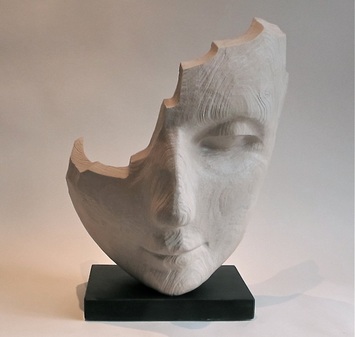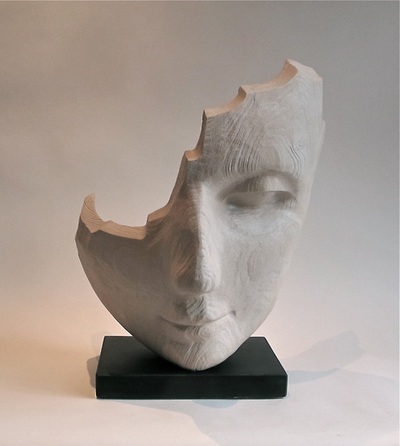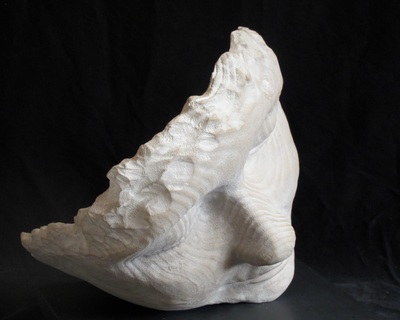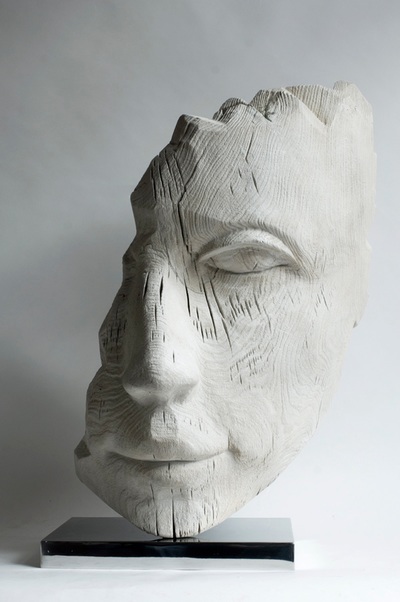
Jilly Sutton’s distinctive sculptures have been exhibited internationally and are in public and private collections across the UK and abroad. She has featured in a number of important Sculpture exhibitions and her carved wooden portrait of the former Poet Laureate, Andrew Motion, is part of the National Portrait Gallery’s permanent collection, having spent a decade on display there.
This November, Jilly Sutton's work is being exhibited for the first time in Wimbledon Village. The group show 'A Christmas Fine Art Feast' will run from 22 November - 6 December, in association with Wimbledon Fine Art.
Ahead of the show, curated by Judy Stafford of staffordgallery, I spoke to the ever humble Jilly about her amazing work over her thirty year career.
This November, Jilly Sutton's work is being exhibited for the first time in Wimbledon Village. The group show 'A Christmas Fine Art Feast' will run from 22 November - 6 December, in association with Wimbledon Fine Art.
Ahead of the show, curated by Judy Stafford of staffordgallery, I spoke to the ever humble Jilly about her amazing work over her thirty year career.
The human face became ingrained in my mind...what else in life is that fascinating?
I understand you started your professional career as a nurse in London, followed by a stint of art teaching. What was it that made you decide to become a sculptor?
I followed my heart! I was always creative, but needed more meaning to the art I’d been creating. I had been carving for a long time but found that Art College really puts me onto a different level with the work. In the end of course I realised that the meaning in my work is often left to the viewer!
You trained as a sculptor at Exeter College of Arts and developed your early career in Nigeria, do you feel that cultural influences play strongly in your work?
Yes, West Africa is full of deeply rooted art and craft. The wood carvings there are strong and symbolic, and have lasted for centuries despite the danger of termite infestations. The Benin Bronzes are amazingly fantastic - perhaps the best, most influential heads I've ever seen.
Over your thirty year career have you experimented widely with different materials? Why did you settle on wood as a medium?
Wood has always been easily available locally - when starting up as an artist one tends to work with what is readily available. Wood is loveable, soft and living. It has warm qualities and an original grain. Admittedly it is also full of unexpected vagaries, with the nature of the material always challenging.
Does your home environment in Devon inspire your work - I understand your home is made of wood too?
Yes - we live in a timber framed, timber clad house, with everything wooden - a solid wooden sink inspired by Castle Drogo!
What is it that inspires you to create figurative work, with a particular focus on faces?
When I trained as a nurse (in another life), I spent a great deal of time working with, washing, and looking at the body. The human face became ingrained in my mind as the most interesting part of the body - what else in life is that fascinating?
How far do your works consider gender?
I keep many, many plaster casts in my studio of family and friends - they’re quite inspiring. With eyes closed and no hair they can look androgynous. Strangely enough, a lot of the heads I create turn out having something recognisable about them.
The works available at the Stafford Gallery this December are 'olive-stone' casts - do you think the faces take on a new identity in casting…are they somehow more flawless, losing an element of rawness that the grain of the wood portrays?
Most of my heads have had good quality molds made for casting in bronze, resins or any medium. The molds pick up every single detail from the original sculpture - even a thumb-print - so nothing is lost and the grain is all there. Obviously patinations, lighting and wear and tear from the elements can change the look of something, which can of course give it a new identity.
How much is your work about beauty vs. humanity?
A good question. It is all about the beauty of humanity. I hope humanity comes through without too much sentimentality - a dirty word at Art College!
The sculptures all seem tranquil, at peace. A certain fragility is expressed where the face is incomplete...considering this and the way that the faces seem ‘at rest’, how far do you feel that your works comment on the fragility of life?
Perhaps I'm guilty of burying my head in the sand about the dark side of life. I leave the reporting of trauma, and any political statements, to artists cleverer at that than me. I have led a lucky, charmed and peaceful life myself and if it all went wrong tomorrow I would still carve peacefulness. The hollowing out and the cut-away areas were originally because of major flaws in the timber, but it has now become a signature.
I understand that your recent work uses Elm wood - do you find that the outcome varies greatly depending on the wood used?
Yes, I did a project on the death of Elm Trees where I dug up about 11 of them with their roots. The project was all about cycles of life and I decorated them with 'Family Tree’ suggestions. 7 are standing in the Scarlet Hotel in Cornwall. Elm wood is extremely hard - I prefer softer woods that sandblast, bringing up the grain more easily.
Have you always enjoyed having a hands on vocation? Did you choose sculpture because of the ability to shape something tangible with your very hands?
As a child I loved my father's old warty, bumpy hands - mine are the same. I always think that I use my hands as my head; my hands are my forte.
Which artists have influenced your practice?
I studied Mitoraj, African works, ancient church carvings, misericords and the 'Green Man' carvings of Norwich and Exeter Cathedral; I wrote my thesis on the 'Foliated Head'. I also enjoyed studying Ana Maria Pacheco. The National Gallery had an amazing installation of her enormous chain-saw carved figures with gesso painted heads in 1999. You couldn't possibly walk amongst them and not be very moved. The Yorkshire Sculpture Park’s Nash exhibition in 2010/11 was also very inspiring.
Looking back, how did it feel selling your first piece of art?
Great! I was with the Rebecca Hossack Gallery in London for over 22 years and she sold everything, but I enjoy going it alone now, exhibiting abroad and locally where I want.
How would you say that your work has developed and changed over the years?
A lot - I sometimes feel embarrassed by very early work - just wish I had stated my practice earlier!
Catch the show from 22nd November - 6th December 2015 at Wimbledon Fine Art at 41 Church Road, Wimbledon Village, SW19 5DQ.
Contact curator Judy Stafford for more information [email protected], 07939 048 436
www.staffordgallery.co.uk
Author: Sarah Moor
I followed my heart! I was always creative, but needed more meaning to the art I’d been creating. I had been carving for a long time but found that Art College really puts me onto a different level with the work. In the end of course I realised that the meaning in my work is often left to the viewer!
You trained as a sculptor at Exeter College of Arts and developed your early career in Nigeria, do you feel that cultural influences play strongly in your work?
Yes, West Africa is full of deeply rooted art and craft. The wood carvings there are strong and symbolic, and have lasted for centuries despite the danger of termite infestations. The Benin Bronzes are amazingly fantastic - perhaps the best, most influential heads I've ever seen.
Over your thirty year career have you experimented widely with different materials? Why did you settle on wood as a medium?
Wood has always been easily available locally - when starting up as an artist one tends to work with what is readily available. Wood is loveable, soft and living. It has warm qualities and an original grain. Admittedly it is also full of unexpected vagaries, with the nature of the material always challenging.
Does your home environment in Devon inspire your work - I understand your home is made of wood too?
Yes - we live in a timber framed, timber clad house, with everything wooden - a solid wooden sink inspired by Castle Drogo!
What is it that inspires you to create figurative work, with a particular focus on faces?
When I trained as a nurse (in another life), I spent a great deal of time working with, washing, and looking at the body. The human face became ingrained in my mind as the most interesting part of the body - what else in life is that fascinating?
How far do your works consider gender?
I keep many, many plaster casts in my studio of family and friends - they’re quite inspiring. With eyes closed and no hair they can look androgynous. Strangely enough, a lot of the heads I create turn out having something recognisable about them.
The works available at the Stafford Gallery this December are 'olive-stone' casts - do you think the faces take on a new identity in casting…are they somehow more flawless, losing an element of rawness that the grain of the wood portrays?
Most of my heads have had good quality molds made for casting in bronze, resins or any medium. The molds pick up every single detail from the original sculpture - even a thumb-print - so nothing is lost and the grain is all there. Obviously patinations, lighting and wear and tear from the elements can change the look of something, which can of course give it a new identity.
How much is your work about beauty vs. humanity?
A good question. It is all about the beauty of humanity. I hope humanity comes through without too much sentimentality - a dirty word at Art College!
The sculptures all seem tranquil, at peace. A certain fragility is expressed where the face is incomplete...considering this and the way that the faces seem ‘at rest’, how far do you feel that your works comment on the fragility of life?
Perhaps I'm guilty of burying my head in the sand about the dark side of life. I leave the reporting of trauma, and any political statements, to artists cleverer at that than me. I have led a lucky, charmed and peaceful life myself and if it all went wrong tomorrow I would still carve peacefulness. The hollowing out and the cut-away areas were originally because of major flaws in the timber, but it has now become a signature.
I understand that your recent work uses Elm wood - do you find that the outcome varies greatly depending on the wood used?
Yes, I did a project on the death of Elm Trees where I dug up about 11 of them with their roots. The project was all about cycles of life and I decorated them with 'Family Tree’ suggestions. 7 are standing in the Scarlet Hotel in Cornwall. Elm wood is extremely hard - I prefer softer woods that sandblast, bringing up the grain more easily.
Have you always enjoyed having a hands on vocation? Did you choose sculpture because of the ability to shape something tangible with your very hands?
As a child I loved my father's old warty, bumpy hands - mine are the same. I always think that I use my hands as my head; my hands are my forte.
Which artists have influenced your practice?
I studied Mitoraj, African works, ancient church carvings, misericords and the 'Green Man' carvings of Norwich and Exeter Cathedral; I wrote my thesis on the 'Foliated Head'. I also enjoyed studying Ana Maria Pacheco. The National Gallery had an amazing installation of her enormous chain-saw carved figures with gesso painted heads in 1999. You couldn't possibly walk amongst them and not be very moved. The Yorkshire Sculpture Park’s Nash exhibition in 2010/11 was also very inspiring.
Looking back, how did it feel selling your first piece of art?
Great! I was with the Rebecca Hossack Gallery in London for over 22 years and she sold everything, but I enjoy going it alone now, exhibiting abroad and locally where I want.
How would you say that your work has developed and changed over the years?
A lot - I sometimes feel embarrassed by very early work - just wish I had stated my practice earlier!
Catch the show from 22nd November - 6th December 2015 at Wimbledon Fine Art at 41 Church Road, Wimbledon Village, SW19 5DQ.
Contact curator Judy Stafford for more information [email protected], 07939 048 436
www.staffordgallery.co.uk
Author: Sarah Moor




 RSS Feed
RSS Feed
